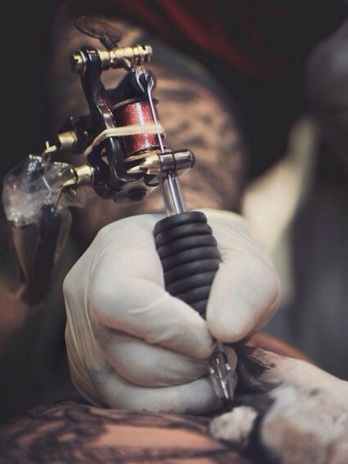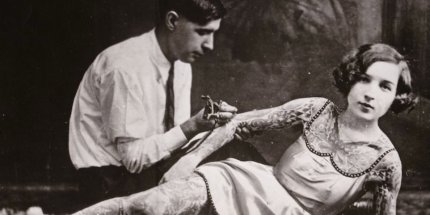Darian Mesneak
WR-121-13
Blog #17
Charlie, an author for Inked Magazine said, “If there is one thing you should know about getting a tattoo first and foremost it should be how to look after and care for it in the extremely important first few weeks after leaving the studio” (1).
 Tattoos are in my opinion are one of the most beautiful acts of art man has created. To view your body as a blank canvas to fill with art that is based on your own expression, feelings or memories is amazing to me. I’m sure by now you have figured out that I probably have tattoos and you would be correct. My whole right arm starting from the top of my hand up to about my shoulder is almost covered and of course, I plan on getting more. I have always been accepting of tattoos because I’ve grown up around them my whole life. Both of my parents are covered in tattoos, all my parent’s friends that would babysit me as a kid were covered in tattoos and a lot of my friend’s parents had tattoos. When I was in middle school I started hanging out at tattoo shops smoking cigarettes with all the tattoo artists and body piercers, watching them tattoo and create gorgeous works of art on people’s bodies. I love it and I hope to be covered head to toe in tattoos someday.
Tattoos are in my opinion are one of the most beautiful acts of art man has created. To view your body as a blank canvas to fill with art that is based on your own expression, feelings or memories is amazing to me. I’m sure by now you have figured out that I probably have tattoos and you would be correct. My whole right arm starting from the top of my hand up to about my shoulder is almost covered and of course, I plan on getting more. I have always been accepting of tattoos because I’ve grown up around them my whole life. Both of my parents are covered in tattoos, all my parent’s friends that would babysit me as a kid were covered in tattoos and a lot of my friend’s parents had tattoos. When I was in middle school I started hanging out at tattoo shops smoking cigarettes with all the tattoo artists and body piercers, watching them tattoo and create gorgeous works of art on people’s bodies. I love it and I hope to be covered head to toe in tattoos someday.
 Now, “Every time a tattoo gun pierces your skin, the needle is opening a wound” (Tinker 1). Tattoos are a bunch of tiny cuts being filled with ink, they are wounds and people should treat them as such. Because they are a wound one of the most important part about getting a tattoo, that I’ve heard from the multiple artists throughout the years, is that you need to keep them clean! It involves a lot to take care of a new tattoo but a clean tattoo really starts at the beginning of the tattoo. What I mean by that is before you sit under the needle you should know that your artist has the proper licenses, that the shop is clean, all the equipment is clean and that all the needles have come from clean packaging. Artists that have a tattooing license through the state must follow certain guidelines called the “Standard universal precautions for preventing the spread of diseases by using sterilization procedures and infection control in body art, body piercing, and tattooing“. These guidelines include three different articles by the Department Of Health under WAC 246-145-015, 246-145-050, and 246-145-060. Those articles are meant to ensure that an artist uses the proper guidelines to keep those who go to get tattoos safe and clean. The problem is that even these articles don’t address the issue of how to take care of your tattoo after you leave the shop.
Now, “Every time a tattoo gun pierces your skin, the needle is opening a wound” (Tinker 1). Tattoos are a bunch of tiny cuts being filled with ink, they are wounds and people should treat them as such. Because they are a wound one of the most important part about getting a tattoo, that I’ve heard from the multiple artists throughout the years, is that you need to keep them clean! It involves a lot to take care of a new tattoo but a clean tattoo really starts at the beginning of the tattoo. What I mean by that is before you sit under the needle you should know that your artist has the proper licenses, that the shop is clean, all the equipment is clean and that all the needles have come from clean packaging. Artists that have a tattooing license through the state must follow certain guidelines called the “Standard universal precautions for preventing the spread of diseases by using sterilization procedures and infection control in body art, body piercing, and tattooing“. These guidelines include three different articles by the Department Of Health under WAC 246-145-015, 246-145-050, and 246-145-060. Those articles are meant to ensure that an artist uses the proper guidelines to keep those who go to get tattoos safe and clean. The problem is that even these articles don’t address the issue of how to take care of your tattoo after you leave the shop.
 “Man dies after swimming with new tattoo” (Tinker 1). Ben Tinker an author for CNN wrote an article about a man who dies from an infection after swimming with a new tattoo. Dying from a tattoo is very uncommon, but if you’re not in a clean environment you are prone to getting an infection. “Tattoo-related infections aren’t common, but they do happen,” says Dr. Daihung Do, an instructor in dermatology at Harvard Medical School and director of cosmetic and laser surgery at Beth Israel Deaconess Medical Center ” (Skerrett 1). How do we protect ourselves once we have the tattoo? Patrick J. Skerrett an author for Harvard Health Publications wrote an article in 2012 offering advice on how to keep your tattoo safe and clean after leaving the shop. This is the advice he offers.
“Man dies after swimming with new tattoo” (Tinker 1). Ben Tinker an author for CNN wrote an article about a man who dies from an infection after swimming with a new tattoo. Dying from a tattoo is very uncommon, but if you’re not in a clean environment you are prone to getting an infection. “Tattoo-related infections aren’t common, but they do happen,” says Dr. Daihung Do, an instructor in dermatology at Harvard Medical School and director of cosmetic and laser surgery at Beth Israel Deaconess Medical Center ” (Skerrett 1). How do we protect ourselves once we have the tattoo? Patrick J. Skerrett an author for Harvard Health Publications wrote an article in 2012 offering advice on how to keep your tattoo safe and clean after leaving the shop. This is the advice he offers.
- After a tattoo session is over, take off the bandage within three to five hours. Wash your hands with antibacterial soap and warm water, then wash the tattooed skin. Pat dry with a paper towel or clean cloth towel.
- Allow the skin to air dry for 5 to 10 minutes. Then apply a very thin layer of Vaseline, Aquaphor, or other ointment.
- Repeat the washing, drying, and moisturizing process three to four times a day for four days.
- When the tattooed skin starts to shed a thin flaky layer of skin, do not scratch or pick at it. At this point you can switch to a moisturizer—don’t let your tattoo get dried out for the first few weeks.
- Call your doctor—not the tattoo artist—if redness or swelling persists after a few days, you have a fever, or you notice a rash in or around the tattoo. (Skerrett 1)
I think the advice that Patrick J. Skerrett offers is great! I follow all of his guidelines for aftercare. The tattoo artist I go to makes all the same suggestions for aftercare and I have never had a problem or had an infected tattoo. I believe that tattoo aftercare is very important and my advice to you is to really think of all the health factors of the tattoo before getting it done. So go get a tattoo, just be safe about it.